Order of National Foundation Merit 건국훈장 (建國勳章)
The original title was the Order of National Foundation Merit 건국공로훈장 (建國功勞勳章). On Jan. 16, 1967 the title was shortened to Order of National Merit 건국훈장 (建國勳章). It is the very first Order created by the Republic of Korea. Its original purpose was to honor those patriotic individuals, both living and dead, who fought against Japanese imperialism from 1895 until Aug. 15, 1945 (the date of the actual surrender of Japanese forces at the end of World War II). Since its inception in April 1949, the Order of National Foundation has also been available to those individuals who have helped to maintain the survival of the Republic of Korea. This would include Harry S Truman and Douglas MacArthur. On Dec. 22, 1951, the Korean government enacted new legislation that included one addition to the award criteria. Anyone who has received the Order of Military Merit, Taeguk Class, is automatically entitled to the First Class of the Order of National Foundation.
During the Syngman Rhee administration, except for himself and the Vice-President Si-Young Lee, the Order of National Foundation Merit was not awarded to any Korean independence activists. During the 12 years of Syngman’s Rhee’s rule, a total of 22 foreigners were awarded the Order of National Foundation. Contrary to what is Wikipedia, the first Order of Merit for National Foundation awarded to a foreigner was not awarded to U.S. Army General James Van Fleet. Interestingly enough, if you look at the minutes of the cabinet meeting held on March 6, 1957, nine years after the establishment of the Korean government, you can confirm that Syngman Rhee at least went through the motions of rewarding independence activists. At the meeting, Syngman Rhee stated, “Compose a national committee to reward and commemorate the martyrs and patriots who died for the independence struggle.” A committee composed of 14 people was formed. The committee determined that 88 people were entitled to the Order of National Foundation Merit, but none of the 88 awards were issued. It was not until Mar. 1, 1962, during the administration of Park Chung Hee, that 204 Koreans were belatedly awarded the Order of National Foundation Merit, and again the following year, there were 229 awards. Unfortunately, due to the Syngman Rhee’s inaction, many independence activists were not recognized for their achievements during their lifetime and received their awards posthumously.
There have been more than 14,000 people who have been awarded this Order. Of these individuals, there are some 5,000 awards where the Korean government has been unable to deliver the award because they have been unsuccessful in locating the individual involved or their descendants.
This Order is not without controversy. There are many individuals who at different points in their lives were pro-Japanese collaborators and then worked for Korean independence. And then there are those who outwardly assisted the Japanese, but secretly worked for Korean Independence. How to decide where their true loyalties lie, is often a matter of debate. On December 10, 2010, the Ministry of Patriots and Veterans Affairs decided to cancel the awards of 19 recipients of the Order of Merit for National Foundation who, after much research, were found to have a history of pro-Japanese activities. There are also known cases where someone, with the same name, claimed the award of a true patriot. There are several ongoing arguments, concerning some recipients who may have gotten a higher award than they deserved, because of whom they know. But this sort of argument is found on virtually all the orders. On the bottom of this page, you will find information on the latest controversies.
1949 SERIES (April)
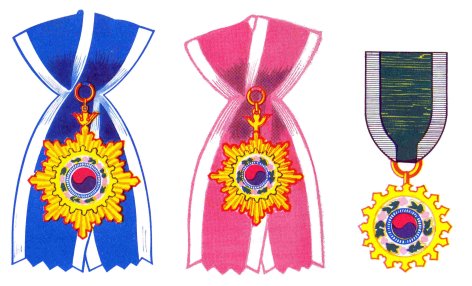
The Order of National Foundation Merit was created on Apr. 27, 1949 by Presidential Decree #82. The original design for the order was in three classes, with no specific name per class. The 1st and 2nd Class Medals are suspended from two pieces of ribbon, which are worn over the left breast pocket. It’s a sort of modified Ladies Bow, and I refer to these as Lesser Grand Cordons. The use of the term “Lesser Grand Cordon” only refers to its physical size characteristics and not to the value of the award. The 3rd Class is a standard breast medal. There are no breast stars, lapel pins or ribbon bars in the 1949 Series. All three medals are worn on the left breast.
- 1st Class Medal 一등장 (一等章) 일등장. The pendant has an 89 mm diameter. The lesser grand cordon is described as woven cloth, 110 mm wide and approx. 220 mm long. The ribbon colors are pale blue 담청색 with two wide white 백색 stripes, one on each side of the center stripe. The award document is 32 × 44 cm (12.6” x 17.3”) in size.
- 2nd Class Medal 二등장 (二等章) 이등장. The pendant has a 75 mm diameter. The lesser grand cordon is described as woven cloth, 110 mm wide and approx. 210 mm long. The ribbon colors are purple 자색지색 with two wide white 백색 stripes, one on each side of the center stripe. The award document is 25 × 41 cm (9.8” x 16.1”) in size.
- 3rd Class Medal 三등장 (三等章) 삼등장. The pendant has a 47 mm diameter. The breast ribbon is described as woven cloth, 42 mm wide. The ribbon colors are pale green 담록지색 with two wide white 백색 stripes, one on each side of the center stripe. The award document is 22 × 36 cm (8.7” x 14.2”) in size.
Syngman Rhee received the very first Order of National Foundation ever issued. He purportedly donated it to his Alma Mater, either Harvard or Princeton University. Yi Si-yeong (1869 ~ 1953) became the first Vice-President of the Republic. In 1949, in honor of his achievements, the Korean government conferred on him, the Order of Merit for National Foundation, 1st Class. These were the only two 1st Class Orders of National Foundation that were issued before 1962. However, during the Korean War, a number of these were issued to American Officers and presented as the Order of Military Merit. The only difference between them was the addition of a Gold or Silver Star to the ribbon above the pendant.
1949 SERIES (April)
On Aug. 5, 1949, the Korean government enacted Presidential Decree #154. There were no changes in the physical features of the actual awards, but the award documents are now 44 × 56 cm (17.3” x 22.0”) in size.
1951 SERIES
On Dec. 22, 1951, the Korean government enacted Presidential Decree #583 for the Order of National Foundation. That legislation added a small change to the award criteria. The legislation states: “Those who are qualified to receive the Taeguk Order of Military Merit and whose achievements are particularly remarkable may be awarded the 1st Class Order of Merit for National Foundation.” It’s not hard to see the logic in their solution. The Republic of Korea was less than two years old when the war started. Defending the country can be viewed as maintaining the Foundation of the Nation. There were no changes in the physical features of the National Foundation awards.
As far as I can determine, General James A. Van Fleet is the only recipient of the Order of Military Merit, Taeguk Class (Dec. 11, 1951) who also received the Order of National Foundation Merit, 1st Class (Jan. 28, 1953) during the Korean War. General Van Fleet is known today as the ‘Father of the Korean Army’. Douglas MacArthur (Jan. 26, 1880 – Apr. 5, 1964) is the only other General who received the Order of Military Merit, Taeguk Class (Sept. 29, 1950) and also received the Order of National Foundation Merit, Republic of Korea Medal. But he received the National Foundation medal posthumously on Dec. 8, 1964. Retired President Harry S Truman also received the same medal on the same day. These medals are considered as “Commemorative” or “Thank You” medals for their participation in the Korean War.
1958 SERIES
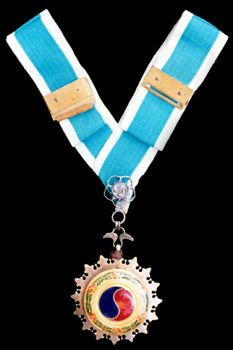
Tanjang Class 단장 (單章)
Several changes were made to the Order of National Foundation on Feb. 27, 1958, under Presidential Decree #1346. All the ribbons are blue 담청색 with two wide white 백색 stripes, one on each side of the center. No dimensions for the width of the stripes is given. There are no ribbon bars or lapel pins referenced, or drawings of, in the original legislation.
All the Classes received specific names.
- The 1st Class was renamed Jung Jang 중장 (重章). Jung means: multiple or fold such as twofold, threefold, etc. It is generally translated as “In the Highest”. Jang is the Korean word for “Medal”. The pendant has a major diameter of 53 mm and weighs 31.1g. The Lesser Grand Cordon that was used on the earlier series First Class Medal is replaced with a Sash. It is worn over the left shoulder. The sash is 1,900 × 85 mm. The breast star has a major diameter of 72 mm and weighs 75g. The sun shape on the medal symbolizes enhancement of national prestige, the mirror shape indicates transition of time (history); the Mugunghwa and leaves, national prestige; Taeguk, national independence. The blue color of the ribbon and the white stripes symbolize the Korean people.
- The 2nd Class was renamed Bok Jang 복장 (複章). Bok means, “Double, to repeat, to reiterate”. The center features of the pendant have not changed, but the sun’s rays are considerably different. The pendant has a major diameter of 60 mm and weighs 49.8g. The Lesser Grand Cordon that was used on the earlier Second Class Medal is replaced with a cravat. The cravat is 27 mm wide, but there is no legal specification for the length.
- The 3rd Class was renamed Tan Jang 단장 (單章). Tan means “Single, alone, only. Simple rather than complex or compound”. The pendant has a major diameter of 47 mm and weighs 24.4 g. Like the second class, the cravat is 27 mm wide, but there is no legal specification for the length.
Several sources were checked to ensure that the dimensions given for the First and Second Class pendants were accurate. Why the Second Class pendant is larger and heavier than the First Class is unknown. There are other variations on the Romanization for the class names, including Chong Jang, Pok Chang, Dan Jang, etc.
1963 SERIES
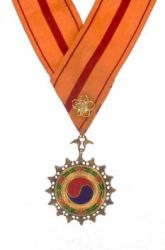
On Dec. 14, 1963, Presidential Decree #1519 was issued. It made significant changes to the Order of National Foundation. The appearance of the 1963 Series is basically identical to the 1958 Series, however, the sizes have changed. Breast Stars have been added to the 2nd and 3rd Classes. Ribbon bars were added to all three Classes. All the ribbon bars for all three classes are identical at 36 × 11 mm, with two 5 mm white stripes, one on each side of a 26 mm blue center. There is a Mugunghwa Flower placed in the center of the ribbon bar. No weights are given in the legislation.

All three ribbon bars are identical except for the Mugunghwa flower in the center.
- Jung Jang 중장 (重章). The pendant has a major diameter of 58 mm. The sash is 1,900 × 85 mm. The sash has a base color of pale blue 담청색, with two 10 mm wide stripes, one on each side of a 65 mm pale blue center stripe. The breast star has a major diameter of 75 mm. The ribbon bar is 35 × 11 mm with two 5 mm white stripes, one on each side of a 26 mm pale blue center. There is a gold Mugunghwa flow in the center of the ribbon bar.
- Bok Jang 복장 (複章). The pendant has a major diameter of 56 mm. The cravat is 600 × 36 mm, with two 5 mm white stripes, one on each side of the 26 mm pale blue center stripe. The breast star has a major diameter of 70 mm. The size and stripes of the ribbon bar are identical to the 1st Class, but the Mugunghwa flower in the center is silver.
- Tan Jang 단장 (單章). The pendant has a major diameter of 52 mm. The cravat is identical to the 2nd Class. The breast star has a major diameter of 55 mm. The size and stripes of the ribbon bar are identical to the 1st Class, but the Mugunghwa flower in the center is bronze.
There have been other examples of this order that have surfaced, which have an Orange Ribbon with Red stripes. There is nothing in the legislation which authorizes these ribbons. It has been suggested that the ribbons are replacements, but there have been multiple examples seen, which would tend to discount them as replacement ribbons. It has also been proposed that the Korean Government wanted certain individuals to stand out from the rest of the National Foundation Award recipients at an award ceremony. The answer is unclear and more research is needed.
1967 SERIES
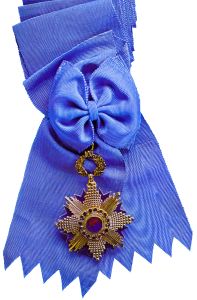
On Feb. 28, 1967, there were major changes made to the Order of National Foundation under Presidential Decree #2929. The name of the Order was shortened from 건국공로훈장 (建國功勞勳章) to 건국훈장 (建國勳章). The new name translates as the Order of National Merit. (I will continue to refer to this order as the Order of National Foundation, less complicated.) There was a small problem with the old name used for the 1st Class. The word Jung 중 (重) is a homophone for the word “medium, middle or center” 중 (中). The distinction, between the two different meanings, is only apparent when they are written in Chinese characters. For Koreans, it was a little confusing when someone hears that a 1st Class Award recipient was awarded the “Medium Medal”. Women’s sizes were added to the first and second classes.
The three Classes were renamed. The Order of Cultural Merit 문화훈장 (文化勳章) ceased to exist, and the names used for the three classes were now used for the Order of National Foundation.1 The appearance of the pendants was also completely redesigned. All three classes have breast stars, ribbon bars and lapel pins. The ribbon bars are 38 × 10 mm in size. The lapel pins are circular with a 17 mm diameter. The symbols employed are: The Mugunghwa leaves found on the suspension device indicate the prosperity of the Republic of Korea. The sun’s rays symbolize the heightened dignity of the country. The wings refer to the high morale of the nation. The mottled area between the sun’s rays symbolizes the brilliance of the hard work. The purple pearls refer to the fruitage of the hard work. The circle around the Taeguk indicates the unity of the nation. The Taeguk, as always, symbolizes the Republic of Korea.
The Class names are:
- The 1st Class was renamed the Republic of Korea Medal 대한민국장 (大韓民國章). The major diameter of the pendant is 60 mm. The sash is 1,700 × 80 mm and is a pale blue with no stripes. The breast star has a major diameter of 70 mm. The ribbon bar is light blue with no stripes and no attachments.
- A Republic of Korea Medal 대한민국장 (大韓民國章) (sized) for Ladies was created. The major diameter of the pendant is 45 mm. The sash is 1700 × 70 mm and is pale blue with no stripes. The breast star has a major diameter of 50 mm. The ribbon bar is light blue with no stripes and no attachments.
- The 2nd Class was renamed the Presidential Medal 대통령장 (大統領章). The pendant has a major diameter of 55 mm. The sash is 1700 × 80 mm. The colors of the sash are: pale blue (1 mm), navy-blue (9 mm), pale blue (60 mm), navy-blue (9 mm) and pale blue (1 mm). The breast star has a major diameter of 60 mm. There are no dimensions given for the stripes on the ribbon bar, but it does resemble the sash with a navy-blue stripe on each side of the center stripe.
- A Presidential Medal 대통령장 (大統領章) (sized) for Ladies. The legislation has a drawing, but states that the Presidential Medal for Ladies is identical to the Republic of Korea Medal (sized) for Ladies. There are no dimensions given. Later legislation gives: The major diameter of the pendant is 45 mm. The sash is 1700 × 70 mm and is pale blue with no stripes. The breast star has a major diameter of 50 mm. The ribbon bar is light blue with no stripes and no attachments.
- The 3rd Class was renamed the National Medal 국민장 (國民章). The pendant has a major diameter of 50 mm. The cravat is 600 × 38 mm. The colors of the sash are: pale blue (4 mm), navy-blue (5 mm), pale blue (20 mm), navy-blue (5 mm) and pale blue (4 mm). The breast star has a major diameter of 55 mm. There are no dimensions given for the stripes on the ribbon bar, but it does appear to be the same as the cravat, with a navy-blue stripe on each side of the Pale blue center stripe.
1969 SERIES
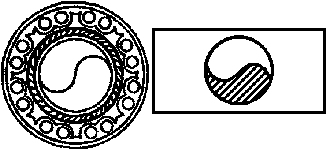
The only change that occurred on Dec. 19, 1969 under Presidential Decree #4466 concerns the lapel pins. The previous series used a 17 mm circular lapel pin, while the 1969 legislation shows a rectangular 12 × 8 mm lapel pin.
- Republic of Korea Medal 대한민국장 (大韓民國章). The lapel pin for both the men’s and ladies size is a solid pale blue with the Taeguk symbol in the center.
- Presidential 대통령장 (大統領章). The lapel pin for both the men’s and ladies size is a pale blue with two wide navy-blue stripes, one on each side of the Taeguk symbol in the center.
- National 국민장 (國民章). The lapel pin for the third class is pale blue with two narrow navy-blue stripes, one on each side of the Taeguk symbol in the center.
1970/1971 SERIES (3)
On June 13, 1970, a new Decoration Law Enforcement Decree 상훈법시행령, Presidential Decree #5035 was enacted. The most significant difference between this legislation and the earlier one is found in the Merit Medals, not the Orders. For the Order of National Foundation Merit, this legislation is identical to the previous 1969 legislation.
On Nov. 17, 1970, a new Decoration Law Enforcement Decree 상훈법시행령, Presidential Decree #5388 was enacted. For the Order of National Foundation Merit, this legislation is also identical to the previous 1969 legislation.
On Jan. 14, 1971, a new Decorations Law Enforcement Decree 상훈법시행령, Presidential Decree #5388 was enacted. For the Order of National Foundation Merit, this legislation is also identical to the previous 1969 legislation.
1971 SERIES
On June 30, 1971, a new Decorations Law Enforcement Decree, Presidential Decree #5688, was issued. The only changes to the Order of National Foundation were changes to the color and stripe patterns on the ribbons, ribbon bars and lapel pins. The ribbons are now red 적색 with yellow 황색 stripes. The red/scarlet color of the ribbon symbolizes a vigorous, combative spirit, and the yellow color symbolizes solidarity.
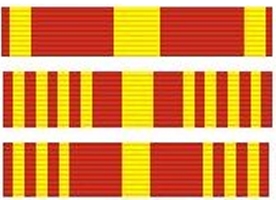
- Republic of Korea Medal 대한민국장 (大韓民國章). The 1700 × 80 mm sash now has three yellow stripes, one on each side and one in the center. The dimensions are: red (5 mm), yellow (5 mm), red (25 mm), yellow (10 mm), red (25 mm), yellow (5 mm) and red (5 mm). The ribbon bar is similar at red (1 mm), yellow (3 mm), red (12 mm), yellow (6 mm), red (12 mm), yellow (3 mm) and red (1 mm). The lapel pin is similar, but no dimensions are given.
- Republic of Korea Medal 대한민국장 (大韓民國章) (sized) for Ladies 숙녀용. The 1700 × 65 mm sash has three yellow stripes, one on each side and one in the center. The dimensions are: red (2.5 mm), yellow (5 mm), red (20 mm), yellow (10 mm), red (20 mm), yellow (5 mm) and red (2.5 mm). The ribbon bar and lapel pin are identical to the men’s size.
- Presidential 대통령장 (大統領章). The 1700 × 80 mm sash has nine yellow stripes, four yellow stripes on each and one yellow stripe in the center. The colors and dimensions are: red (5 mm), yellow (2.5 mm), red (2.5 mm), yellow (2.5 mm), red (2.5 mm), yellow (2.5 mm), red (2.5 mm), yellow (2.5 mm), red (14 mm), yellow (7 mm), red (14 mm), yellow (2.5 mm), red (2.5 mm), yellow (2.5 mm), red (2.5 mm), yellow (2.5 mm), red (2.5 mm), yellow (2.5 mm), and red (5 mm). The ribbon bar is similar. The colors and dimensions are: red (2 mm), yellow (1.5 mm), red (1.5 mm), yellow (1.5 mm), red (1.5 mm), yellow (1.5 mm), red (1.5 mm), yellow (1.5 mm), red (5 mm), yellow (3 mm), red (5 mm), yellow (1.5 mm), red (1.5 mm), yellow (1.5 mm), red (1.5 mm), yellow (1.5 mm), red (1.5 mm), yellow (1.5 mm), and red (2 mm). The lapel pin is similar, but no dimensions are given.
- Presidential 대통령장 (大統領章) (sized) for Ladies 숙녀용. The 1700 × 65 mm sash has nine stripes, four yellow stripes on each and one yellow stripe in the center. The colors and dimensions are: red (5 mm), yellow (2 mm), red (2 mm), yellow (2 mm), red (2 mm), yellow (2 mm), red (2 mm), yellow (2 mm), red (10 mm), yellow (7 mm), red (10 mm), yellow (2 mm), red (2 mm), yellow (2 mm), red (2 mm), yellow (2 mm), red (2 mm), yellow (2 mm), and red (5 mm). The ribbon bar and lapel pin are identical to the men’s size.
- National 국민장 (國民章). The 600 × 38 mm cravat now has seven yellow stripes, with three yellow stripes on each side and one in the center. The dimensions are: red (2 mm), yellow (1.5 mm), red (1.5 mm), yellow (1.5 mm), red (1.5 mm), yellow (1.5 mm), red (8 mm), yellow (3 mm), red (8 mm), yellow (1.5 mm), red (1.5 mm), yellow (1.5 mm), red (1.5 mm), yellow (1.5 mm) and red (2 mm). The ribbon bar and lapel pin are similar, but no dimensions are given.
1984 SERIES
On Jan. 23, 1984 under Presidential Decree #11336, significant changes were made to the Order of National Foundation
- Republic of Korea Medal 대한민국장 (大韓民國章). The pendant has a major diameter of 70 mm and weighs 104.5g. The sash is a little longer at 1800 × 80 mm but still has three yellow stripes, one on each side and one in the center. The dimensions of the stripes are the same as the previous series. The breast star is a little larger at 80 mm and weighs 130g. The ribbon bar is the same as the previous series. The lapel pin is also similar, but the new decree gives dimensions for the stripes and colors, which are: red (1.5 mm), yellow (0.5 mm), red (2.5 mm), yellow (1 mm), red (2.5 mm), yellow (0.5 mm) and red (1.5 mm).
- Republic of Korea Medal 대한민국장 (大韓民國章) – Sized for Women 숙녀용. The pendant has a major diameter of 55 mm and weighs 66.5g. The sash is 1700 × 65 mm and still has three yellow stripes, one on each side and one in the center. The dimensions of the stripes are: red (2.5 mm), yellow (3 mm), red (23 mm), yellow (8 mm), red (23 mm), yellow (3 mm), and red (2.5 mm). The breast star is a little larger at 60 mm and weighs 75.5g. The ribbon bar and the lapel pin are identical to the men’s size.
- Presidential 대통령장 (大統領章). The pendant has a major diameter of 60 mm and weighs 78g. The sash is a little longer at 1800 × 80 mm and still has 4 yellow stripes on each and one yellow stripe in the center. The dimensions of the stripes are the same as the previous series. The breast star is 70 mm and weighs 101g. The ribbon bar is the same as the previous series. The lapel pin is also similar, but the new decree gives dimensions, which are: red (1.5 mm), yellow (0.2 mm), red (0.2 mm), yellow (0.2 mm), red (0.2 mm), yellow (0.2 mm), red (0.2 mm), yellow (0.2 mm), red (1.6 mm), yellow (1 mm), red (1.6 mm), yellow (0.2 mm), red (0.2 mm), yellow (0.2 mm), red (0.2 mm), yellow (0.2 mm), red (0.2 mm), yellow (0.2 mm), and red (1.5 mm).
- Presidential 대통령장 (大統領章) – Sized for Women 숙녀용. The pendant has a major diameter of 50 mm and weighs 56g. The 1700 × 65 mm sash has four 2 mm yellow stripes on each and one 7 mm yellow stripe in the center. The sash colors and dimensions are the same as the previous series. The ribbon bar and lapel pin are identical to the current men’s size.
- National 국민장 (國民章). The pendant has a major diameter of 50 mm and weighs 53.5g. The 600 × 38 mm cravat still has three yellow stripes on each side and one in the center. The dimensions are the same as the previous series. The breast star has a major diameter of 55 mm and weighs 64.5g. The ribbon bar is also the same as the previous series. The lapel pin now has dimensions given, which are: red (1.5 mm), yellow (0.3 mm), red (0.3 mm), yellow (0.3 mm), red (0.3 mm), yellow (0.3 mm), red (1.5 mm), yellow (1 mm), red (1.5 mm), yellow (0.3 mm), red (0.3 mm), yellow (0.3 mm), red (0.3 mm), yellow (0.3 mm), and red (1.5 mm).
1990 SERIES
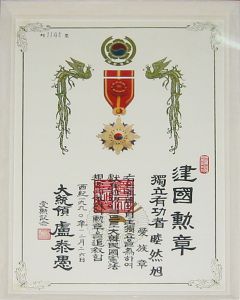
On July 3, 1990, under the Decorations Law Enforcement Decree, Presidential Decree #13040, the National Foundation Order of merit was changed from three classes to five. The restoration of diplomatic ties with Russia (1990) and China (1992) gave the Korean government new opportunities to broaden their understanding of the Korean Independence Movement (독립운동 – 獨立運動) in those countries. The research, conducted by the Patriots and Veterans Affairs Administration (PVAA), has resulted in many previously unknown patriots being decorated. More classes were needed because of the Patriots and Veterans Administration Agency efforts to find and ‘properly’ reward those individuals who worked for the establishment of the Republic of Korea. The three class system did not allow enough flexibility. The first two classes kept the same names, but the National or 3rd Class was expanded into three different classes. The new 5th Class 애족장 (愛族章) is commonly translated as “National Medal” but a more accurate translation is “National Pride Medal”. A brief look at the Korean and Chinese spelling, shows that the original 3rd Class 국민장 (國民章) was not simply relegated down to 5th.2 The Decorations Law Decree #4222, (Jan. 13, 1990) states: “The Presidential Citation awarded for national founding or independence merit awarded before this Act enters into force may be reexamined and awarded as the 4th or 5th grade or the National Foundation Merit Medal under the amended provisions of Article 11”. A committee was created to examine the original 3rd class awards and either confirm them as 3rd Class or re-award them as 4th or 5th Class Medals based on the merits of the original award.
- Republic of Korea Medal 대한민국장 (大韓民國章). There were no physical changes from the previous 1984 Series.
- Republic of Korea Medal 대한민국장 (大韓民國章) – Sized for Women 숙녀용. There were no physical changes from the previous 1984 Series.
- Presidential 대통령장 (大統領章). There were no physical changes from the previous 1984 Series.
- Presidential 대통령장 (大統領章) – Sized for Women 숙녀용. There were no physical changes from the previous 1984 Series.
- Independent 독립장 (獨立章). The new 3rd Class medal has the same design, dimensions, and weight as the previous 3rd Class. The only difference is the name found on the reverse of the medal.
- Patriot 애국장 (愛國章). The pendant has a major diameter of 50 mm and weighs 52g. The breast ribbon is 100 × 38 mm and has five yellow stripes, two on each side and one in the center. The dimensions are: red (2 mm), yellow (1.5 mm), red (2 mm), yellow (1.5 mm), red (10.5 mm), yellow (3 mm), red (10.5 mm), yellow (1.5 mm), red (2 mm), yellow (1.5 mm), and red (2 mm). The ribbon bar has the same colors and stripe dimensions as the breast ribbon. There is a rosette on the drape. The lapel pin is similar to the ribbon and ribbon bar, but the stripe dimensions are smaller at red (1.5 mm), yellow (.3 mm), red (.4 mm), yellow (.3 mm), red (2 mm), yellow (1 mm), red (2 mm), yellow (.3 mm), red (.4 mm), yellow (.3 mm), and red (1.5 mm).
- National Pride 애족장 (愛族章). The pendant has a major diameter of 50 mm and weighs 52g. The breast ribbon is 100 × 38 mm and has three yellow stripes, one on each side of the center and one in the center. The dimensions are: red (2 mm), yellow (2 mm), red (13.5 mm), yellow (3 mm), red (13.5 mm), yellow (2 mm), and red (2 mm). There is a rosette on the drape. The ribbon bar has the same colors and stripe dimensions as the breast ribbon. The lapel pin is similar to the ribbon and ribbon bar, but the stripe dimensions are smaller at red (2 mm), yellow (.5 mm), red (2 mm), yellow (1 mm), red (2 mm), yellow (.5 mm), and red (2 mm).
Today, the First Class of the Order of National Foundation is regarded as the most honored medal in Korea. Although the Grand Order of Mugunghwa is stipulated by law as the highest medal, it is regarded as being less impressive. This is because it is self-granted by the President and because it is given as a gift to foreign heads of state. In either case, it is not given based on significant accomplishments impacting Korea. A Korean President, regardless of his approval rating, still receives the Grand Order of Mugunghwa. This order can be a very difficult one to find. Koreans take great pride in their family history, especially when it is supported by a National Foundation Medal.
CURRENTLY
Since 1990, the Decorations Law Enforcement Decree has been changed 16 times. The current legislation is Presidential Decree #30517 and was enacted on March 10, 2020. In the intervening years, the only major changes were to the Order of National Foundation Merit, Republic of Korea Medal (sized) for Ladies and the Presidential Medal also (sized) for Ladies. They were found to be discriminatory and were dropped in 2016.3 There has been two minor wording changes concerning the ribbon colors. The Korean legislation originally used the term 적색 for red, which in Korea, is strongly connected to Socialism/Communism, as in “Red Scare, Red Menace, Red Square, etc.”. They now use the term 볽은색, which still translates as red, but it’s more of a deeper red. The Korean legislation also originally used the term 황색 for yellow. They now use the term 노란, which also translates as yellow. The difference is caused by the word “색” meaning color. The term 노란 has the meaning color embedded within it. To say, 노란색 would technically translate as “Yellow color color”. Even so, I will use continue to use the word 색 to mean color, as it is easier to understand for most of my readers. All the other sizes, patterns, etc., of the 1990 legislation, are still in effect.
The current classes for the Order of National Foundation are:
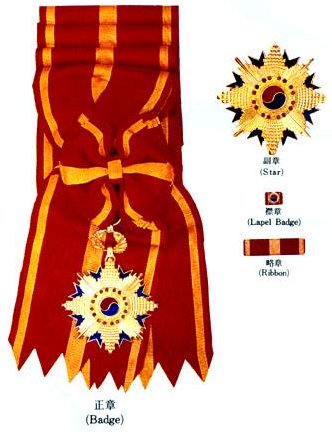
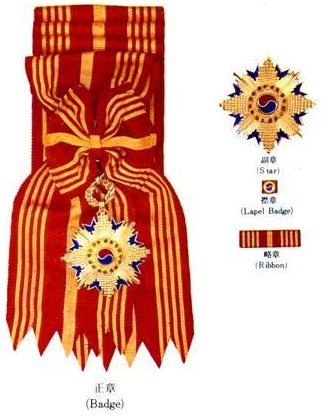
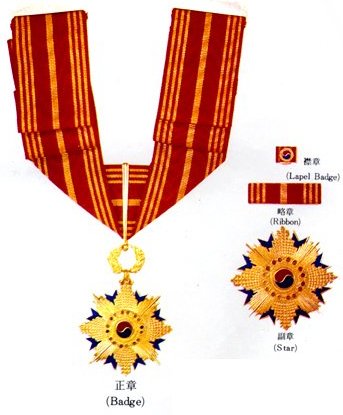
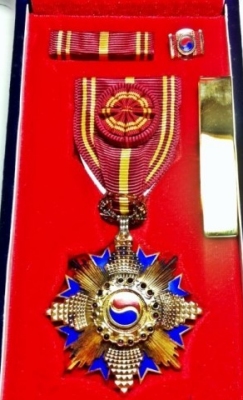
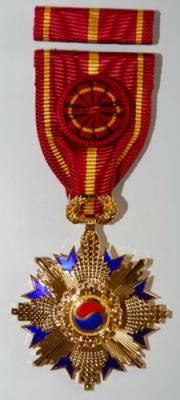
CONTROVERSIES
The restoration of formal diplomatic relations with Russia (1990) and China (1992) gave the Korean government new opportunities to broaden their understanding of the Korean Independence Movement (독립운동 – 獨立運動). This has led to a new controversy. Many recipients or their descendants feel that they were not given an award proportional to their total number of achievements, based on the new information that has come to light since first being decorated. They feel that their award should be upgraded. Park Min-sik 박민식, the Minister of Patriots and Veterans Affairs (May 12, 2022 – Dec. 26, 2023) said, “In the case of those who have been rewarded in the past, medals are granted only with the data confirmed at the time, so it is inevitable that unfair cases will arise at the time when additional historical materials are discovered.”

There are legal difficulties which prohibit the re-evaluation process. The “Awards and Decorations Act” 상훈법 (賞勳法)4 specifically prohibits duplicate awards for the same achievement.5 In fact, there has been no case of changing the level of an award, except during the expansion of the Order of National Foundation from three classes to five, which took place in 1990. These award level changes did not involve the upgrading of an award, but the downgrading from third class to fourth or fifth. The upgrading of an award is not prohibited by current legislation. But to legally upgrade an award, the original lower-class award needs to be rescinded, but under the current legislation that can only be done if the original award was based on false information.6 Interestingly enough, it is legal to award an individual a second decoration based on an entirely different set of accomplishments. This is what happened to Yeo Woon-hyung 여운형 (呂運亨, 1886 ~ 1947). On Mar. 1, 2005, he was posthumously awarded the Order of National Foundation, President Class (a 2nd Class), and on Feb. 21, 2008, he was awarded the Order of National Foundation, Republic of Korea Class (a 1st class).
Another problem with the Order of National Foundation is what is termed the ‘Exclusion’ 배제. The independence movement is described as having started with the March 1st 1919 Demonstrations. The preamble of the Korean Constitution does not recognize efforts before Mar. 1, 1919.7 Patriots who fought the Japanese before the March 1st demonstration, and, who for one reason or another did not continue the fight after that date, are not eligible. And those who did continue the fight after March 1st 1919, are only evaluated from that date going forward. Much of the Donghak Peasant Revolution 동학농민혁명 was fought against the growing Japanese influence over Korea and what was perceived as detrimental foreign influence, both Western and Christian. Jeon Bong-jun 전봉준 (全琫準) and Choi Si-hyeong 최시형 (崔時亨) of the 2nd Donghak Peasant Army, who fought against the Japanese army’s invasion of Gyeongbok Palace 경복궁, are, according to the Exclusion Policy, not eligible for the Order of National Foundation.
As a result of these controversies, the Ministry of Patriots and Veterans Affairs 국가보훈부 (國家報勳部) formed the “National Response Committee for Class/Grade for Independence Movement” (독립운동 훈격 국민공감위원회). They held their first meeting on Mar. 7, 2023, with the purpose of putting in place a system of tight standards for the re-evaluation process. Opinions from the public are invited. The committee was only expected to run for about six months. However, as of Feb. 2024, the committee has not released any results, and it appears that they are trying to define patriotism. Currently, it appears that left leaning independence fighters are not to be considered patriots.
Interesting little side note: Many Koreans feel that Kim Si-hyeon 김시현 (金始顯) and Yoo Si-tae 유시태 (柳時泰), both independence fighters in their own right, should be awarded the Order of National Foundation. However, they attempted to assassinate Syngman Rhee on June 25, 1952. It is felt by some Koreans that the attempted assassination of Syngman Rhee was not entirely wrong, a fact that became apparent when Syngman Rhee was forced into exile due to student demonstrations in 1960. Both men were released from prison in 1961 by Park Chung Hee. Unfortunately, we do not know how Park Chung Hee evaluated the assassination attempt, but neither man has ever received the Order of National Foundation. Keep in mind that one country’s patriotic revolutionaries are often considered terrorists, extremists, or fanatics by another country. Some of Korea’s greatest patriots were executed by Japan as terrorists. Kim Si-hyeon and Yoo Si-tae were fighting for an independent Korea.
Footnotes:
- The Order of Cultural Merit was absorbed by the Order of Civil Merit on Jan. 16, 1967 under Decorations Law #1885. The Order of Cultural Merit was later reinstated in 1973.
- Decorations Enforcement Decree #13040, Addendum 부칙, part ②
- Decorations Law Enforcement Decree 상훈법 시행령, Presidential Decree #26838 대통령령 제26838호, dated 2015.12.31 and implemented on 2016.1.1.[시행 2016.1.1.], partial revision 일부개정].
- [시행 2020. 3. 11.] [법률 제16765호, 2019. 12. 10., 일부개정] [Enforced on March 11, 2020] [Law No. 16765, December 10, 2019, partially revised]
- 제4조(중복 수여의 금지) Award Act, Article 4 Prohibition of Duplicate Awards
- 상훈법, 제8조 서훈의 취소 등 Awards and Decorations Act, Article 8 Cancellation of Distinguished Service, etc. An award can also be nullified if a person has committed a crime concerning national security and has been sentenced or has fled to a hostile area (North Korea). It can also be revoked in cases where the awardee has been sentenced to the death penalty, life imprisonment or imprisonment for a period of not less than one year.
- “…imbued with the sublime spirit of independence as manifested in the March First Movement…” Constitution of the Republic of Korea 대한민국헌법 (大韓民國憲法) (Oct. 27, 1980) “…upholding the cause of the Provisional Republic of Korea Government, born of the March First Independence Movement of 1919…” Constitution of the Republic of Korea 대한민국헌법 (大韓民國憲法) Oct. 29, 1987.
